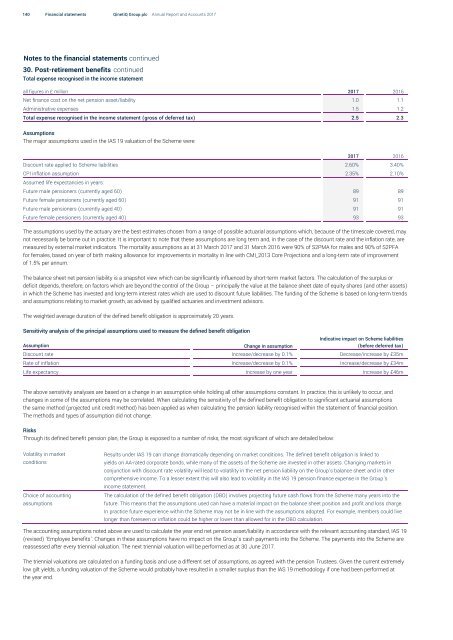QinetiQ Annual Report 2017
You also want an ePaper? Increase the reach of your titles
YUMPU automatically turns print PDFs into web optimized ePapers that Google loves.
140<br />
140<br />
Financial<br />
Financial statements<br />
statements <strong>QinetiQ</strong><br />
<strong>QinetiQ</strong> Group<br />
Group<br />
plc<br />
plc<br />
<strong>Annual</strong><br />
<strong>Annual</strong><br />
<strong>Report</strong><br />
<strong>Report</strong><br />
and<br />
and<br />
Accounts<br />
Accounts<br />
<strong>2017</strong><br />
<strong>2017</strong><br />
www.qinetiq.com<br />
Notes to the financial statements continued<br />
30. Post-retirement benefits continued<br />
Total expense recognised in the income statement<br />
all figures in £ million <strong>2017</strong> 2016<br />
Net finance cost on the net pension asset/liability 1.0 1.1<br />
Administrative expenses 1.5 1.2<br />
Total expense recognised in the income statement (gross of deferred tax) 2.5 2.3<br />
Assumptions<br />
The major assumptions used in the IAS 19 valuation of the Scheme were:<br />
<strong>2017</strong> 2016<br />
Discount rate applied to Scheme liabilities 2.60% 3.40%<br />
CPI inflation assumption 2.35% 2.10%<br />
Assumed life expectancies in years:<br />
Future male pensioners (currently aged 60) 89 89<br />
Future female pensioners (currently aged 60) 91 91<br />
Future male pensioners (currently aged 40) 91 91<br />
Future female pensioners (currently aged 40) 93 93<br />
The assumptions used by the actuary are the best estimates chosen from a range of possible actuarial assumptions which, because of the timescale covered, may<br />
not necessarily be borne out in practice. It is important to note that these assumptions are long term and, in the case of the discount rate and the inflation rate, are<br />
measured by external market indicators. The mortality assumptions as at 31 March <strong>2017</strong> and 31 March 2016 were 90% of S2PMA for males and 90% of S2PFA<br />
for females, based on year of birth making allowance for improvements in mortality in line with CMI_2013 Core Projections and a long-term rate of improvement<br />
of 1.5% per annum.<br />
The balance sheet net pension liability is a snapshot view which can be significantly influenced by short-term market factors. The calculation of the surplus or<br />
deficit depends, therefore, on factors which are beyond the control of the Group – principally the value at the balance sheet date of equity shares (and other assets)<br />
in which the Scheme has invested and long-term interest rates which are used to discount future liabilities. The funding of the Scheme is based on long-term trends<br />
and assumptions relating to market growth, as advised by qualified actuaries and investment advisors.<br />
The weighted average duration of the defined benefit obligation is approximately 20 years.<br />
Sensitivity analysis of the principal assumptions used to measure the defined benefit obligation<br />
Indicative impact on Scheme liabilities<br />
Assumption<br />
Change in assumption<br />
(before deferred tax)<br />
Discount rate Increase/decrease by 0.1% Decrease/increase by £35m<br />
Rate of inflation Increase/decrease by 0.1% Increase/decrease by £34m<br />
Life expectancy Increase by one year Increase by £46m<br />
The above sensitivity analyses are based on a change in an assumption while holding all other assumptions constant. In practice, this is unlikely to occur, and<br />
changes in some of the assumptions may be correlated. When calculating the sensitivity of the defined benefit obligation to significant actuarial assumptions<br />
the same method (projected unit credit method) has been applied as when calculating the pension liability recognised within the statement of financial position.<br />
The methods and types of assumption did not change.<br />
Risks<br />
Through its defined benefit pension plan, the Group is exposed to a number of risks, the most significant of which are detailed below:<br />
Volatility in market<br />
conditions<br />
Choice of accounting<br />
assumptions<br />
Results under IAS 19 can change dramatically depending on market conditions. The defined benefit obligation is linked to<br />
yields on AA-rated corporate bonds, while many of the assets of the Scheme are invested in other assets. Changing markets in<br />
conjunction with discount rate volatility will lead to volatility in the net pension liability on the Group’s balance sheet and in other<br />
comprehensive income. To a lesser extent this will also lead to volatility in the IAS 19 pension finance expense in the Group’s<br />
income statement.<br />
The calculation of the defined benefit obligation (DBO) involves projecting future cash flows from the Scheme many years into the<br />
future. This means that the assumptions used can have a material impact on the balance sheet position and profit and loss charge.<br />
In practice future experience within the Scheme may not be in line with the assumptions adopted. For example, members could live<br />
longer than foreseen or inflation could be higher or lower than allowed for in the DBO calculation.<br />
The accounting assumptions noted above are used to calculate the year end net pension asset/liability in accordance with the relevant accounting standard, IAS 19<br />
(revised) ‘Employee benefits’. Changes in these assumptions have no impact on the Group’s cash payments into the Scheme. The payments into the Scheme are<br />
reassessed after every triennial valuation. The next triennial valuation will be performed as at 30 June <strong>2017</strong>.<br />
The triennial valuations are calculated on a funding basis and use a different set of assumptions, as agreed with the pension Trustees. Given the current extremely<br />
low gilt yields, a funding valuation of the Scheme would probably have resulted in a smaller surplus than the IAS 19 methodology if one had been performed at<br />
the year end.
















